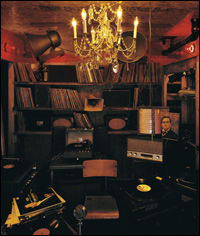“Sensorium, Part 1” and Alix Pearlstein at MIT, Cecily Brown at the MFA
By RANDI HOPKINS | October 3, 2006

Janet Cardiff and George Bures Miller, Opera for a Small Room |
I love the term “remote sensing” in MIT’s press release for “Sensorium: Embodied Experience, Technology, and Contemporary Art, Part 1,”which opens at MIT’s List Visual Arts Center on October 12. This heady, two-part exhibition examines the influence of technology on the experiences our bodies are having in this world. “Remote sensing,” which evokes the oxymoronic combo of distance and immediacy, turns out to refer to something entirely familiar, the manner in which telephones and various screens and monitors (from TV to surveillance) deliver aural and visual sensations to us. But a variety of contemporary artists have been exploring the wider implications of this kind of experience for us humans, examining ways in which technology has come to impact and infiltrate our personal intake of sensory information. For “Sensorium, Part 1,” Berlin-based, Norwegian-born Sissel Tolaas uses sophisticated scent-reproduction technologies to create a room infused with “microencapsulated” smells. You can rub the walls to release the odors and leave a visible record of your own visit. There’s an elaborate theatrical installation by Canadian artists Janet Cardiff and George Bures Miller, who create an extended fiction based on finding a stack of opera records in a second-hand store in out-of-the-way Salmon Arms, British Columbia. Mathieu Briand, Ryoji Ikeda, and Bruce Nauman likewise contribute sensate works.Also opening at the List on October 12, “Alix Pearlstein: The King, the Mice, and the Cheese” offers three recent videos by an artist known for setting up intense psychological narratives that explore issues of power and control, then directing friends, professional actors, and others to play out her scenes for the camera. Because of her use of stylized gestures and a minimalist æsthetic, Pearlstein’s scenarios have been described as “abstract dramas” that allow you to project your own relationships into the story.
Abstraction meets the human figure in a whole different way in the canvases of the British painter who is the subject of “Cecily Brown,” which opens in the Museum of Fine Arts’ Foster Gallery on October 18. This provocative artist’s passion for paint, admiration for predecessors from Goya and Velázquez to De Kooning and Francis Bacon, and top-notch ancestry (she’s the daughter of the late art critic David Sylvester) have been duly noted in the extensive press that has followed her since her first, sexy solo shows at Deitch Projects in NYC in 1997 and 1998. The MFA will present 18 canvases, from 1997 to the present.
“Sensorium: Embodied Experience, Technology, and Contemporary Art, Part 1” and “Alix Pearlstein: The King, the Mice and the Cheese” at MIT List Visual Arts Center, 20 Ames St, Cambridge | October 12–December 31 | 617.253.4400 | “Cecily Brown” at Museum of Fine Arts, 465 Huntington Ave, Boston | October 18–January 15 | 617.267.9300
On theWeb
MIT List Visual Arts Center: //web.mit.edu/lvac
Museum of Fine Arts: //www.mfa.org
 Topics
Topics:
Museum And Gallery
, Massachusetts Institute of Technology, Painting, Visual Arts, More  , Massachusetts Institute of Technology, Painting, Visual Arts, Cultural Institutions and Parks, Museums, Museum of Fine Arts, List Visual Arts Center, Francis Bacon, Cecily Brown, David Sylvester, Less
, Massachusetts Institute of Technology, Painting, Visual Arts, Cultural Institutions and Parks, Museums, Museum of Fine Arts, List Visual Arts Center, Francis Bacon, Cecily Brown, David Sylvester, Less 